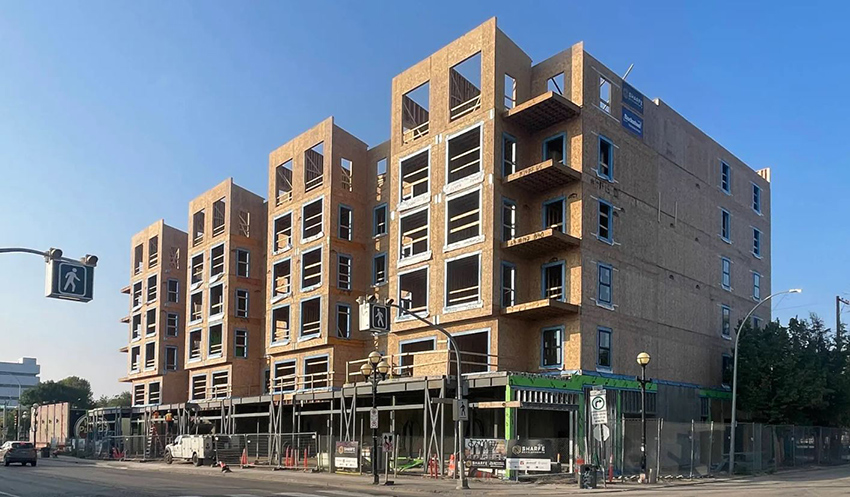By Brent Bellamy, Architect + Creative Director
Originally published in the Winnipeg Free Press
The amount of ink being spilled over Canada’s housing crisis is enough to make the global climate crisis feel neglected and envious.
The post-pandemic spike of Canada’s housing costs, particularly rental rates, has politicians tripping over each other to announce their solutions. The Canada Mortgage and Housing Corporation (CMHC) has identified that to stabilize housing costs by levelling market demand, Canada must add 3.5 million more homes (170,000 in Manitoba) to its current construction rates by 2030. This number has been repeated so often that it has reduced the public discourse about housing affordability to one of mere housing supply.
Image: A new housing development at 197 Osborne St. is an example of creating density in an existing neighbourhood. Photo - Supplied.
This simplification of the issue has precluded more nuanced discussion such as the alignment of housing type with housing need. Simply increasing market supply doesn’t address the requirement for social and supportive housing to tackle homelessness and core housing need. It doesn’t create new affordable homes for lower income residents, and ignores the specific housing needs of seniors, students, and immigrant families, while overlooking the differing challenges of homeownership and rentals.
Simply increasing housing supply also doesn’t consider where housing is being built. For the last 50 years, cities have grown primarily through suburban sprawl, leading to an urban form that is economically and environmentally unsustainable.
If we are going to build enough homes to eliminate the housing crisis, while also creating cities that are livable, equitable, and financially prosperous, new construction can no longer rely solely on sprawling subdivisions and downtown apartment towers. Growth and densification must occur across all neighbourhoods in the city.
Most people want to be part of a community, living on a residential street, close to amenities like schools, shopping, transit, community centres and parks. Socially equitable growth will mean providing affordable access to existing neighbourhoods for new residents. Achieving this requires ending exclusionary single-family zoning, allowing basement and garden suites, duplexes, fourplexes, townhomes, and even small apartment blocks to be built on residential streets.
A political sound bite that has gained traction, is the need to “remove the gatekeepers” standing in the way of housing construction. These gatekeepers are largely portrayed as civic politicians, bureaucrats and planning departments that slow development approvals.
The real gatekeepers, however, are local residents who consistently oppose change and densification in their neighbourhoods. City governments are so directly accountable to their constituents that hyperlocal priorities are inevitably reflected in decision making, with big-picture goals often getting lost in the process.
Zoning and neighbourhood plans can reflect this public desire to resist change, even when the long-term benefits are well understood. If residents more readily supported new development, local governments would reflect these priorities, and the approval gates would be unlocked.
Understanding the need for a cultural change in how civic governments respond to local concerns, the federal government has implemented a new $4-billion program called the Housing Accelerator Fund. The program goes beyond simply increasing supply and responds to the nuances of Canada’s housing need, by incentivizing local governments to remove barriers to residential development, and create a diverse, affordable, and equitable housing supply.
Cities across the country have submitted applications to the program and are currently negotiating approval. To be eligible for funding, cities established their current baseline of housing construction and committed to growth targets that increase supply by at least 10 per cent each year. A minimum of seven new policy initiatives were identified to directly support the targeted housing growth, with funding provided to give cities the financial ability to implement these plans. The program ensures that money provided is not lost in the bureaucracy by being results-based, with funds being given for every new home created.
The Housing Accelerator Fund targets different housing types through a sliding scale of financial incentives. For every new unit created above the baseline, cities will receive $20,000, increasing to $32,000 for multi-family housing embedded in existing neighbourhoods, $35,000 for homes near rapid transit, and $39,000 for affordable housing. The City of Winnipeg’s application hopes to receive $192 million if its target of 5,300 new homes over three years is reached.
The program provides cities with the ability to identify specific housing needs and design their strategies to target the most impactful outcomes. Some cities may need more market housing, others may need to address homelessness in a greater way. A program that has the federal government working collaboratively with cities allows this flexibility.
The seven new initiatives are intended to be the lasting vehicle of long-term change in the program, as cities must identify structural shifts in their planning and approvals policies to have their proposals accepted.
Winnipeg, as an example, is promising to: upgrade infrastructure where the city anticipates development interest, expand online building permit applications, create new departments to work with the non-profit sector and redevelop city-owned properties, and implement rapid zoning and local area plan amendments to establish higher density infill development as-of-right.
Calgary is boldly proposing to allow at least a duplex on every residential lot.
Canada’s housing crisis has many complex variables. At a time when housing supply needs acceleration, construction costs are at an all-time high and the Bank of Canada is increasing interest rates with the explicit goal of slowing housing construction.
The Housing Accelerator Fund could redefine how cities build housing today, and in the future, but it’s only one piece of a very large puzzle. The most important step we can take individually, is to understand that when we oppose higher densities and housing diversity in our own neighbourhoods, we are opposing a new home for someone else, making us the root cause of the housing affordability crisis.
Brent Bellamy is creative director at Number TEN Architectural Group.


